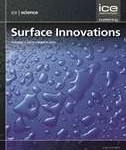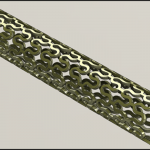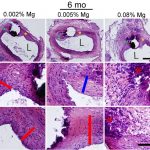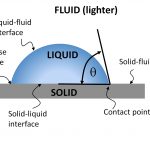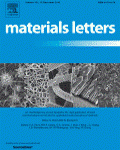We are glad to report that the journal impact factor (IF) for Surface Innovations rose to 2.333 from 1.268 in 2018. This is the third year in a row when the journal climbs in ranking. The journal is listed under two categories:
1) Materials Science, Coatings & Films
The journal climbed from 14th to 6th position among 20 listed journals. Percentile improve from 74% in last year to 30% in 2019. It places the journal under Q2 category.
2) Physical Chemistry
The journal moved from 118th position to 78th among 148 journals. The percentile improved from 81% (Q4) to 53% (Q3).
Journal Impact Factor
PhD Candidate
Mr. Kyle Hrubecky has joined our research team as a PhD Candidate. He will work on just-awarded NIH R01 grant, developing new zinc alloys for medical applications. Kyle worked with us in the past as undergraduate researcher, during his junior year.
NIH R01 Grant
The U.S. National Institute of Health has awarded us with R01 funding. Our laboratory has been working to refine the composition and microstructure of biodegradable Zn-based binary alloys and test their behavior in the vascular environment over the last four years in an effort to develop a metal with mechanical properties and biocompatibility required for endovascular stent applications. Having contributed enormously to the scientific understanding of Zn-based systems, we are now ready to develop more complex Zn-based alloys with 2-3 alloying elements that meet benchmark values for biodegradable stents, including: 1) have superior corrosion fatigue resistance that eliminates early stage (6 to 9 months) fracturing of biodegradable stents (common problem in Mg-based and Zn-based stents prototyped in the last several years); 2) maintain in vivo corrosion rates close to the 0.02 mm/year value; 3) exhibit >200 MPa yield strength, and >25-30% elongation to failure; and 4) demonstrate biocompatibility in terms of short- and long-term inflammatory responses, re-endothelialization, and suppressed intimal hyperplasia, similar or better than 316L stainless steel (industrial standard for stent materials).
Surface Effect on Biocompatibility
Our new paper entitled In Vitro Corrosion and in Vivo Response to Zinc Implants with Electropolished and Anodized Surfaces has been published in the ACS Applied Materials & Interfaces journal. Roger Guillory, PhD candidate, and Prof. Jeremy Goldman from Biomedical Engineering led this project. In this study, pure zinc samples were electropolished (EP) and anodized (AD) to engineer oxide films with distinctive physical and degradation characteristics, as determined by potentiodynamic polarization, electrochemical impedance spectroscopy and static immersion tests. The samples were then implanted within the aortic lumen of adult Sprague Dawley rats to determine the influence of surface engineering on biocompatibility responses to Zn implants. It was found that in vitro corrosion produced a porous corrosion layer for the EP samples and a densified layer on the AD samples. The AD material was more resistant to corrosion, while localized corrosion and pitting was seen on the EP surface. Interestingly, the increased variability from localized corrosion due to surface film character translated directly to the in vivo performance, where 100% of the AD implants but only 44% of the EP implants met the biocompatibility benchmarks. Overall, the results suggest that oxide films on degradable zinc critically affect early neointimal progression and overall success of degradable Zn materials.
SI Volume 7 Issue 3-4
We are glad to share with you the content of the Issue 3-4 of 2019 of Surface Innovations with nine papers on variety of topics related to surfaces and interfaces, including Invited Feature Article on chemistry of self-adaptive materials prepared by Prof. Ekaterina Skorb and her team. Hope you will find something interesting in this collection.
History of Contact Angles
The first and only one review on history of contact angles was prepared by a team of international experts led by Prof. Drelich. The contact angle is one of the most sensitive experimental values describing a junction between three phases, being influenced by the composition and properties of contacting media as well as the structure and composition of interfaces involved. The origins and importance of the contact angle in analysis of three phase systems dates back to the famous works on cohesion and adhesion of fluids published by Thomas Young in 1805 and later Athanase Dupré in 1869. Since then, the contact angle has remained one of the most important values measured experimentally during characterization of solids and their wetting characteristics. Such measurements, however, involve solid surfaces that deviate from the idealized ones used in thermodynamic and mechanical modelling of three-phase junction by Young, Dupré, and others, and there is typically more than one value of contact angle measured on such surfaces. As a result, the attention of scientists and researchers in the last two centuries has been on development of methods for accurate contact angle measurements, interpretation of experimental values, and understanding the causes for contact angle value variation and contact angle hysteresis. The article entitled Contact Angles: History of Over 200 Years of Open Questions, and published in the Surface Innovations journal, reviews advancements made in interpretation of experimental contact angles and their use in characterization of solid surfaces.
NIH R15 Grant
Our close collaborator Prof. Jeremy Goldman from the Biomedical Engineering program has been awarded with the NIH R15 grant entitled Inhibition of Neointimal Hyperplasia by Zinc-based Biodegradable Arterial Devices. This two-year project, to which Prof. Jaroslaw Drelich serves as Co-PI, will allow us to correlate a range of zinc and zinc alloy corrosion rates with the degree of suppressed intimal hyplerplasia. We hypothesize that a corrosion rate that is too low will preserve mechanical strength of the metal but not effectively suppress intimal hyperplasia, while a rate that is too high will prematurely degrade the mechanical scaffold and simultaneously produce toxic effects that provoke harmful inflammatory responses and ultimately exacerbate intimal hyperplasia. Under this project, we will also progress our efforts in engineering of implant surfaces by controlling the surface oxide film thickness and its quality.
Correcting Contact Angles
A new review on contact angles from SURFI team has been published in the Advances in Colloid and Interface Science journal, entitled Contact Angles: From Past Mistakes to New Developments through Liquid-Solid Adhesion Measurements.
A contact angle observed for a liquid-solid system is not necessarily a unique value and a few different contact angles need to be carefully considered in relation to liquid spreading, adhesion and phase separation. Despite the conceptual simplicity of the contact angle and over 200 years of investigation, interpretations of experimental contact angles remain controversial, and mistakes are quite common. Here, the physics behind equilibrium contact angles are restated and their misuse in modern literature is briefly discussed. Selected advances made in the 20th century that shaped current interpretations of experimental contact angles are also critically reviewed and evaluated. Understanding of contact angles for liquids on solids has improved in the last two decades and this progress is driven by advanced imaging techniques and improved methodologies in contact angle measurements, often in tandem with direct force measurements for liquid droplets in contact with solids. In our laboratory, a microelectronic balance system is employed to measure the force of liquid droplet spontaneous spreading and the water-solid adhesion forces at different stages of droplet retraction and separation. A microbalance equipped with a camera and data acquisition software measures these forces directly, monitors droplet-surface separation including distances over which the droplet stretches, and collects optical images simultaneously. The images are used to analyze capillary and surface tension forces based on measured droplet dimensions, shapes of surfaces and values of contact angles. These force measurements have significantly furthered our fundamental understanding of advancing, receding and most stable contact angles, and their correlations with adhesion, and are summarized in this review.
Keynote on Fish Skin and More
Prof. Jarek Drelich attended the 148th Annual TMS Meeting & Exhibition in San Antonio, TX and delivered a keynote address entitled Fish Skin: A Natural Inspiration for Novel Materials and Coatings during the symposium Green Materials Engineering; An EPD Symposium in Honor of Sergio Monteiro. Adam Drelich was the first author of this contribution. Prof. Drelich also co-authored the second keynote address entitled Natural Fibers Reinforced Polymer Composites Applied in Ballistic Multilayered Armor for Personal Protection: An Overview that was delivered by Prof. Sergio Monteiro from the Military Institute of Engineering in Rio de Janeiro, Brazil.
The program of the Symposium on Biological Materials Science during this TMS meeting also included invited presentation Effect of Orientation on Water-repellant Legs of Water-walking Insects by Georgia Hurchalla and Jarek Drelich. This invited talk was also presented by Prof. Drelich.
Superplastic Zinc Alloy
In our new article entitled Precipitation Induced Room Temperature Superplasticity in Zn-Cu Alloys published in Materials Letters, the effect of grain size and precipitates on tensile properties of Zn-1.0Cu alloy are discussed. The alloy was cold rolled and annealed to manipulate the grain size and precipitation of CuZn4 particles at grain boundaries. Cold rolling resulted in an almost ultrafine-grained structure alongside precipitation of nano-sized CuZn4 particles. Mechanically induced precipitates triggered room temperature superplasticity through activation of Zn/CuZn4 boundary sliding, exhibiting maximum elongation of 470% at the strain rate of 1.0 × 10−4 s−1. Short-time annealing led to significantly reduced strain rate sensitivity due to the reduction of CuZn4 fraction, while the grain size remained nearly intact. This suggests that precipitates rather than grain size mainly influence the mechanical properties of Zn alloys.
